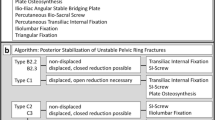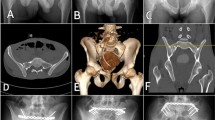Abstract
Purpose
The purpose of this study was to examine hospital quality measures and the long-term functional outcomes associated with lateral compression type 1 [LC1] pelvic ring injuries.
Methods
A query was performed from December 2011 to September 2020 at two institutions within one hospital system for patients with a pelvic fracture diagnosis. Chart review was performed on admitted patients to determine demographic information, medical co-morbidities (to calculate Charlson Co-morbidity Index), in-hospital complications, length of stay [LOS], discharge disposition, and 30-day readmission rates. All patients included were treated nonoperatively. An attempt was made to contact all patients for long-term follow-up to assess current functional status with a Short Musculoskeletal Function Assessment [SMFA].
Results
Two-hundred and eighty-six patients were included, with 172 (65.9%) patients admitted and analyzed with respect to hospital quality measures. Patients admitted were older (83 vs 80 years, p = 0.015) with more medical co-morbidities (p = 0.001) than those discharged from the emergency department. The average LOS was 5.7 ± 3.7 days and 31 (18%) experienced in-hospital complications. The inpatient mortality rate was 1.2%, and the 30-day readmission rate was 8.1%. When comparing admitted patients without concomitant injuries, admitted patients with concomitant injuries, and non-admitted patients, admitted patients with concomitant injuries were found to have more medical co-morbidities (p = 0.001). Forty-three patients were available for long-term follow-up (average 36.6 ± 7.3 months), with an average SMFA score of 29.0 ± 25.7.
Conclusions
Patients admitted for LC1 pelvic fractures are likely to be older with more medical co-morbidities, and up to 1/5th will experience inpatient complications. Although inpatient mortality remains low, this injury pattern can lead to significant functional disability that persists for several years after injury.
Similar content being viewed by others
References
Colby SL, Ortman JM (2014) Projections of the Size and Composition of the U.S. Population: 2014 to 2060, Current Population Reports, P25-1143. U.S. Census Bureau, Washington, DC
Burge R, Dawson-Hughes B, Solomon DH, Wong JB, King A, Tosteson A (2007) Incidence and economic burden of osteoporosis-related fractures in the United States, 2005–2025. J Bone Min Res 22(3):465–475. https://doi.org/10.1359/jbmr.061113
Kannus P, Parkkari J, Niemi S, Sievänen H (2015) Low-trauma pelvic fractures in elderly Finns in 1970–2013. Calcif Tissue Int 97(6):577–580. https://doi.org/10.1007/s00223-015-0056-8
Clement ND, Court-Brown CM (2014) Elderly pelvic fractures: the incidence is increasing and patient demographics can be used to predict the outcome. Eur J Orthop Surg Traumatol 24(8):1431–1437. https://doi.org/10.1007/s00590-014-1439-7
Krappinger D, Kammerlander C, Hak DJ, Blauth M (2010) Low-energy osteoporotic pelvic fractures. Arch Orthop Trauma Surg 130(9):1167–1175. https://doi.org/10.1007/s00402-010-1108-1
Burgess AR et al (1990) Pelvic ring disruptions: effective classification system and treatment protocols. J Trauma Injury Infect and Crit Care 30(7):848–856. https://doi.org/10.1097/00005373-199007000-00015
Marsh JL (2009) OTA fracture classification. J Orthop Trauma 23(8):551. https://doi.org/10.1097/BOT.0b013e3181ad5e92
Weaver MJ, Bruinsma W, Toney E, Dafford E, Vrahas MS (2012) What are the patterns of injury and displacement seen in lateral compression pelvic fractures? Clin Orthop Relat Res® 470(8):2104–2110. https://doi.org/10.1007/s11999-012-2364-x
Leslie MP, Baumgaertner MR (2013) Osteoporotic pelvic ring injuries. Orthop Clin North Am 44(2):217–224. https://doi.org/10.1016/j.ocl.2013.01.007
Gaski GE, Manson TT, Castillo RC, Slobogean GP, OʼToole RV (2014) Nonoperative treatment of intermediate severity lateral compression type 1 pelvic ring injuries with minimally displaced complete sacral fracture. J Orthop Trauma 28(12):674–680. https://doi.org/10.1097/BOT.0000000000000130
Dechert TA, Duane TM, Frykberg BP, Aboutanos MB, Malhotra AK, Ivatury RR (2009) Elderly patients with pelvic fracture: interventions and outcomes. Am Surg 75(4):291–295
Holstein JH, Pizanis A, Köhler D, Pohlemann T, and Working Group Quality of Life After Pelvic Fractures (2013) What are predictors for patients’ quality of life after pelvic ring fractures? Clin Orthop Relat Res® 471(9):2841–2845. https://doi.org/10.1007/s11999-013-2840-y.
Samuel AM et al (2016) Variation in resource utilization for patients with hip and pelvic fractures despite equal medicare reimbursement. Clin Orthop Relat Res 474(6):1486–1494. https://doi.org/10.1007/s11999-016-4765-8
Swiontkowski MF, Engelberg R, Martin DP, Agel J (1999) Short musculoskeletal function assessment questionnaire: validity, reliability, and responsiveness. J Bone Joint Surg 81(9):1245–1260
Marsh JL et al (2007) “Fracture and dislocation classification compendium—2007: ORTHOPAEDIC Trauma Association Classification, Database and Outcomes Committee. J Orthop Trauma. https://doi.org/10.1097/00005131-200711101-00001
Balogh Z et al (2007) The epidemiology of pelvic ring fractures: a population-based study. J Trauma Injury Infect Crit Care 63(5):1066–1073. https://doi.org/10.1097/TA.0b013e3181589fa4
Taillandier J, Langue F, Alemanni M, Taillandier-Heriche E (2003) Mortality and functional outcomes of pelvic insufficiency fractures in older patients. Joint Bone Spine 70(4):287–289
Bible JE, Kadakia RJ, Wegner A, Richards JE, Mir HR (2013) One-year mortality after isolated pelvic fractures with posterior ring involvement in elderly patients. Orthopedics 36(6):760–764. https://doi.org/10.3928/01477447-20130523-21
Ting B, Zurakowski D, Herder L, Wagner K, Appleton P, Rodriguez EK (2014) Preinjury ambulatory status is associated with 1-year mortality following lateral compression Type I fractures in the geriatric population older than 80 years. J Trauma Acute Care Surg 76(5):1306–1309. https://doi.org/10.1097/TA.0000000000000212
Soni A, Gupta R, Kapoor L, Vashisht S (2020) Functional outcome of ‘LC-1 pelvic ring injury with incomplete sacral fracture’ managed non-operatively. J Clin Orthop Trauma 11(Suppl 1):S1–S3. https://doi.org/10.1016/j.jcot.2019.09.013
Hagen J, Castillo R, Dubina A, Gaski G, Manson TT, O’Toole RV (2016) Does surgical stabilization of lateral compression-type pelvic ring fractures decrease patients’ pain, reduce narcotic use, and improve mobilization? Clin Orthop Relat Res 474(6):1422–1429. https://doi.org/10.1007/S11999-015-4525-1
Parry JA, Salameh M, Funk A, Heare A, Stacey SC, Mauffrey C (2021) Mobilization versus displacement on lateral stress radiographs for determining operative fixation of minimally displaced lateral compression type I (LC1) pelvic ring injuries. Int Orthop 45(6):1625–1631. https://doi.org/10.1007/S00264-020-04912-3
Egol KA, Koval KJ, Zuckerman JD (2015) Handbook of fractures, 5th edn. Wolters Kluwer Health, Philadelphia
Abernathy BR, Schroder LK, Bohn DC, Switzer JA (2021) Low-energy pelvic ring fractures: a care conundrum. Geriatr Orthop Surg Rehabilit. https://doi.org/10.1177/2151459320985406
Lefaivre KA, Slobogean GP, Ngai JT, Broekhuyse HM, O’Brien PJ (2014) What outcomes are important for patients after pelvic trauma? Subjective responses and psychometric analysis of three published pelvic-specific outcome instruments. J Orthop Trauma 28(1):23–27. https://doi.org/10.1097/BOT.0b013e3182945fe9
Hunsaker FG, Cioffi DA, Amadio PC, Wright JG, Caughlin B (2002) The American academy of orthopaedic surgeons outcomes instruments: normative values from the general population. J Bone Joint Surg 84-A(2):208–215
Kugelman DN, Fisher N, Konda SR, Egol KA (2019) Loss of ambulatory independence following low-energy pelvic ring fractures. Geriatr Orthop Surg Rehabilit 10:215145931987810. https://doi.org/10.1177/2151459319878101
Funding
No funding was received to assist with the preparation of this manuscript.
Author information
Authors and Affiliations
Contributions
All authors contributed to the study conception and design. Material preparation, data collection, and analysis were performed by Nina Fisher, Sara Solasz, and Assefa Tensae. The first draft of the manuscript was written by Nina Fisher, and all authors commented on previous versions of the manuscript. All authors read and approved the final manuscript.
Corresponding author
Ethics declarations
Conflict of interest
Sanjit Konda is a consultant for Stryker. Kenneth Egol is a consultant for Exactech and Synthes, receives royalties from Exactech, Wolters Kluwer, and Slack Inc, receives research support from Synthes and Acumed, and is a paid lecturer for Smith and Nephew. The remaining authors have no relevant financial or non-financial interests to disclose.
Ethics approval
Institutional review board [IRB] approval was obtained for this study.
Additional information
Publisher's Note
Springer Nature remains neutral with regard to jurisdictional claims in published maps and institutional affiliations.
Rights and permissions
About this article
Cite this article
Fisher, N.D., Solasz, S.J., Tensae, A. et al. Low-energy lateral compression type 1 (LC1) pelvic ring fractures in the middle-aged and elderly affect hospital quality measures and functional outcomes. Eur J Orthop Surg Traumatol 32, 1379–1384 (2022). https://doi.org/10.1007/s00590-021-03125-7
Received:
Accepted:
Published:
Issue Date:
DOI: https://doi.org/10.1007/s00590-021-03125-7




